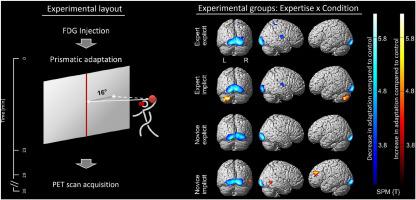Journal of Neuroscience Methods ( IF 3 ) Pub Date : 2020-12-25 , DOI: 10.1016/j.jneumeth.2020.109061 Ganna Blazhenets 1 , Alexander Kurz 2 , Lars Frings 1 , Christian Leukel 3 , Philipp T Meyer 1

|
Background
Speed of performance improvements and the strength of memory consolidation in humans vary with movement expertise. Underlying neural mechanisms of behavioural differences between levels of movement expertise are so far unknown.
New method
In this study, PET with [18F]fluorodeoxyglucose (FDG) was proposed as a powerful novel methodology to assess learning-related brain activity patterns during large non-restricted movements (ball throwing with a right hand). 24 male handball players (‘Experts’) and 24 male participants without handball experience (‘Novices’) performed visuomotor adaptations to prismatic glasses with or without strategic manoeuvres (i.e., explicit or implicit adaptation).
Results
Regional changes in FDG uptake as a marker of neuronal activity, relative to a control condition, were assessed. Prismatic adaptation, in general, was associated with decreased occipital neuronal activity as a possible response to misleading visual information. In ‘Experts’, the adaptation was associated with altered neuronal activity in a network comprising the right parietal cortex and the left cerebellum. In ‘Novices’, implicit adaptation resulted in an activation of the middle frontal and inferior temporal gyrus.
Comparison with existing methods
This study demonstrates the versatility of FDG PET for studying brain activations patterns in experimental settings with unrestricted movements that are not accessible by other techniques (e.g., fMRI or EEG).
Conclusions
Observed results are consistent with the involvement of different functional networks related to strategic manoeuvres and expertise levels. This strengthens the assumption of different mechanisms underlying behavioural changes associated with movement expertise. Furthermore, the present study underscores the value of FDG PET for studying brain activation patterns during unrestricted movements.
中文翻译:

运动专家和新手在视觉运动适应过程中的大脑激活模式:FDG PET研究,运动不受限制
背景
在人类中,性能提高的速度和内存整合的强度随运动专业知识而变化。到目前为止,运动专业水平之间的行为差异的潜在神经机制尚不清楚。
新方法
在这项研究中,PET与[ 18 F]氟脱氧葡萄糖(FDG)被提议作为一种强大的新颖方法,用于评估在大型非受限运动(右手投球)过程中与学习有关的大脑活动模式。24名男性手球运动员(“专家”)和24名没有手球经验的男性参与者(“新手”)对棱镜眼镜进行视觉运动适应,无论是否进行策略性操作(即,显式或隐式适应)。
结果
相对于对照条件,评估了FDG摄取的区域变化作为神经元活性的标志。通常,棱柱形适应与枕神经元活动减少有关,这可能是对误导性视觉信息的可能反应。在“专家”中,这种适应与包括右顶叶皮层和左小脑的网络中神经元活动的改变有关。在“新手”中,内隐的适应导致额中回和颞下回的激活。
与现有方法的比较
这项研究证明了FDG PET的多功能性,可用于研究实验环境中具有其他技术(例如fMRI或EEG)无法访问的无限制运动的大脑激活模式。
结论
观察到的结果与与战略演习和专业知识水平有关的不同功能网络的参与一致。这强化了与运动专业知识相关的行为改变所依据的不同机制的假设。此外,本研究强调了FDG PET在研究无限制运动过程中大脑激活模式方面的价值。


























 京公网安备 11010802027423号
京公网安备 11010802027423号